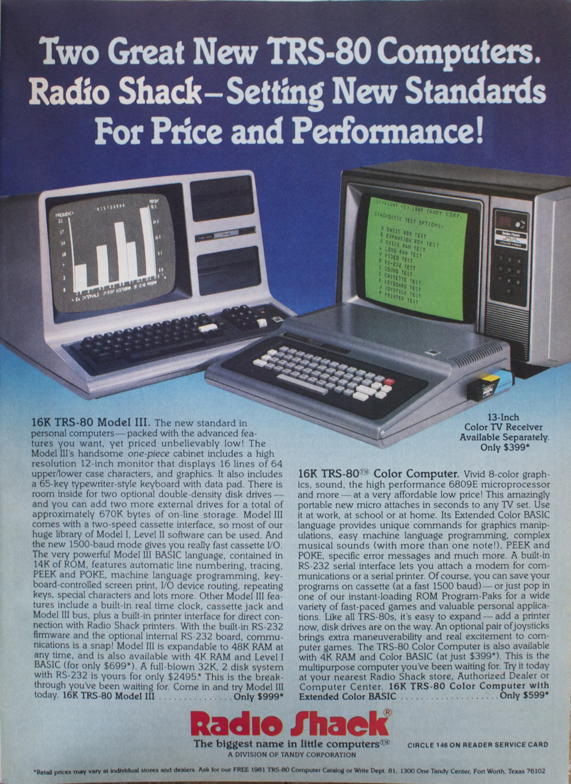Radio Shack advertises the Color Computer vs. the Model III
Going through my old creative computing magazines, I ran across this ad from Radio Shack, highlighting both the TRS-80 Model III and the TRS-80 Color Computer, both introduced in 1980.
The Model III screen is pretty standard for ads of the time, showing off its use as a business computer. The CoCo screen, not so much. The “Vivid 8-color graphics” are represented as a green screen with black text. And take a close look at that black text. The software they’re advertising isn’t a game, or business charts, or even colorful word processing. It’s the diagnostics cartridge. I’m pretty sure that cartridge did not even come with the computer.
Other computer companies advertised by showing—besides games, charts, and word processing—programming code, mathematical analysis, and even rudimentary paintings. What market was Radio Shack targeting with diagnostics text? That same year they had cartridges for chess, checkers, a game called Quasar Commander, and pinball. Any of those would have been a better choice for an advertisement showing off the “vivid graphics” of the Color Computer.
I only have five issues of creative computing, all from 1981; the January issue had a review of the Color Computer, and is the only issue in which I could find an ad for it. There was another ad in August for the TRS-80 Model III only, advertising it for classroom use.
In response to 80-Micro and the TRS-80, 1983-1984: I’m going through some old 80-Micro magazines, and two editorials a year apart caught my eye.
- Tandy’s Little Wonder: F. G. Swygert (PDF)
- “A complete history and reference guide to the CoCo and all related hardware, software, and support sources.”
More Color Computer
- Simple game menu for the Color Computer 2 with CoCoSDC
- This simple menu provides one screen for cartridges saved in the CoCoSDC’s flash ROM, and any number of screens for your favorite games for your friends to play.
- Rainbow Magazine preflight tool enhanced
- I’ve added several features to the Rainbow Magazine preflight tool, including a check for references to line numbers that don’t exist.
- CoCoFest! 2021
- Forty years later, I finally make it to CoCoFest!
- BASIC tokenization examined
- Why do old BASIC programs have strange characters in their .BAS files? Why do they look like they’re compiled code?
- What are the 8 bits in 8-bit computing?
- Retro computing is often called 8-bit computing. This is because the bytes that these computers use are composed of eight bits, and much of what the computer does is operating on these individual bits, not on the byte as a whole.
- 19 more pages with the topic Color Computer, and other related pages
More Radio Shack
- Priming the Pump: How TRS-80 Enthusiasts Helped Spark the PC Revolution
- David and Theresa Welsh wrote some of the first great software for the TRS-80, and knew a lot of the other people who were also writing great software. In Priming the Pump, they talk about the history of personal computers and the first non-kit mass-market personal computer, the TRS-80 Model I.
More TRS-80
- Tandy Assembly 2018
- Tandy Assembly was earlier this November, and I have never seen so many Radio Shack computers in one spot. Also, my love affair with daisy wheels is rekindled.
- The Radio Shack Postal Service
- What if Radio Shack had been granted a monopoly on computers in 1981? They’d probably look a lot like the United States Postal Service.
- 80-Micro and the TRS-80, 1983-1984
- I’m going through some old 80-Micro magazines, and two editorials a year apart caught my eye.
- Baseball in the rain
- In 1980, after I bought a personal computer, I wrote a simple computer program in BASIC and sold it to one of the many magazines at the time. To the second-major newspaper of the area, this was a big deal.
- Priming the Pump: How TRS-80 Enthusiasts Helped Spark the PC Revolution
- David and Theresa Welsh wrote some of the first great software for the TRS-80, and knew a lot of the other people who were also writing great software. In Priming the Pump, they talk about the history of personal computers and the first non-kit mass-market personal computer, the TRS-80 Model I.

